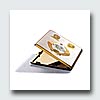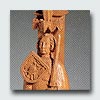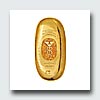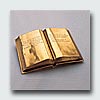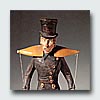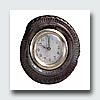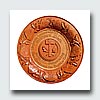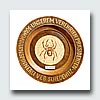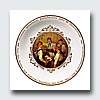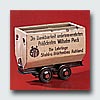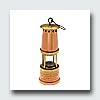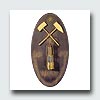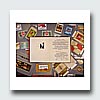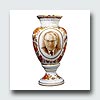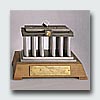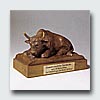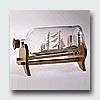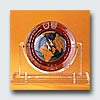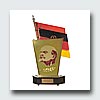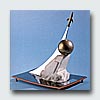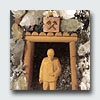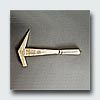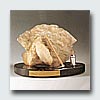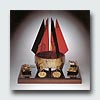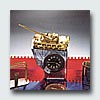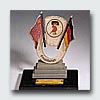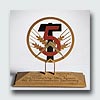|
Birthday and Anniversary Presents
by Andreas Michaelis
 One
might be forgiven for thinking that birthdays, even those that come in
round figures, are essentially private or indeed contemplative occasions.
Not so, if the birthday boy happens to be the head of a state or Party
or is in some other way in the public eye. In that case, a birthday becomes
a public event. The guests can no longer be hand-picked, nor the tidal
wave of presents averted. Gifts made to GDR leaders, if they were of the
right kind, tended to end up in the museum. They included both highly
individual pieces and items off the mass production conveyor belts. These
souvenirs sometimes commemorated significant social occasions, sometimes
insignificant; some were presented by governments, some by ordinary working
people; and, while some might be suited to the personality and office
of a president, others were given in friendship or comradeship. One
might be forgiven for thinking that birthdays, even those that come in
round figures, are essentially private or indeed contemplative occasions.
Not so, if the birthday boy happens to be the head of a state or Party
or is in some other way in the public eye. In that case, a birthday becomes
a public event. The guests can no longer be hand-picked, nor the tidal
wave of presents averted. Gifts made to GDR leaders, if they were of the
right kind, tended to end up in the museum. They included both highly
individual pieces and items off the mass production conveyor belts. These
souvenirs sometimes commemorated significant social occasions, sometimes
insignificant; some were presented by governments, some by ordinary working
people; and, while some might be suited to the personality and office
of a president, others were given in friendship or comradeship.
Along with presents to mark birthdays or other occasions in the lives
of the state and Party leaders, there are certain items that were presented
by home or foreign givers on particular GDR anniversaries. Most of these,
and the oldest too, were left by Wilhelm Pieck at his death. One remarkable for its origins was given to him in Moscow in December
1943: a desktop calendar handcrafted out of wood for the Communist leader
by German prisoners of war in the Soviet Union. The red crayon inscription
reads: »Unity and peace to the German people - Wilhelm Pieck - From antifascist
prisoners of war in USSR p.o.w. camp 158«.
One remarkable for its origins was given to him in Moscow in December
1943: a desktop calendar handcrafted out of wood for the Communist leader
by German prisoners of war in the Soviet Union. The red crayon inscription
reads: »Unity and peace to the German people - Wilhelm Pieck - From antifascist
prisoners of war in USSR p.o.w. camp 158«.
Three presents given to Wilhelm Pieck in Soviet exile in 1936, on his
sixtieth birthday, have survived. They were made by Soviet industries,
using material from the current production line, and represent a kind
of gift that seems to have appeared for the first time in the USSR in
the 20s. These presents signalled a deliberate rejection of feudal or
bourgeois traditions and a liberation from the material and artistic values
of an old societal system then supposed defunct, and their meaning to
the recipient lay purely in their symbolic function. Doubtless it would
be going too far to suggest that there was an individual artistic style
of expression peculiar to socialism as practised in the Communist bloc
countries - but it remains true that this kind of characteristic symbolic
gift was in evidence in almost every east European country till the late
1980s.
 »The
workers« at the factory or plant in question would normally be identified
as the givers of presents of this sort. Thus Wilhelm Pieck was given a
ball-bearing mount by the workforce at the 1st State Ball-Bearing Works,
a clock (inevitably) by the workforce at the 2nd State Clock Factory in
Moscow »The
workers« at the factory or plant in question would normally be identified
as the givers of presents of this sort. Thus Wilhelm Pieck was given a
ball-bearing mount by the workforce at the 1st State Ball-Bearing Works,
a clock (inevitably) by the workforce at the 2nd State Clock Factory in
Moscow and
a smoker's set made of cogwheels by the Sergo Orjonikidse Machine Tools
Works. and
a smoker's set made of cogwheels by the Sergo Orjonikidse Machine Tools
Works. In
1954 the workers at Zeulenroda furniture factory took In
1954 the workers at Zeulenroda furniture factory took Pieck by surprise when they remembered an anniversary he had probably
forgotten himself: in 1894, the President, then an apprentice carpenter,
had joined the German Woodworkers' Association, and his fellows in the
craft were keen to mark his diamond jubilee as an active member of the
trade union movement. On the side of the chest they made to celebrate
the occasion is an image of Stalinallee (Stalin Avenue) in East Berlin,
which East Germany touted as the premier »socialist street« in »the capital
of the GDR«.
Pieck by surprise when they remembered an anniversary he had probably
forgotten himself: in 1894, the President, then an apprentice carpenter,
had joined the German Woodworkers' Association, and his fellows in the
craft were keen to mark his diamond jubilee as an active member of the
trade union movement. On the side of the chest they made to celebrate
the occasion is an image of Stalinallee (Stalin Avenue) in East Berlin,
which East Germany touted as the premier »socialist street« in »the capital
of the GDR«.
Naturally the Communist bloc had another tradition, first practised in
the Soviet Union: the naming of cities, factories, co-operatives, streets
and public amenities after prominent Communist personalities, often when
they were still alive. A danger was concealed in this kind of honour,
however. If a personality fell out of favour, or was downgraded by his
successors, the names all had to be changed. Thus cities, works and streets
named after Stalin were renamed almost immediately after the 20th congress
of the Soviet Communist Party in 1956, and Stalin memorials were toppled.
Stalin was dropped from the leadership hall of fame. The boulevard once
known as Stalin Avenue became Karl Marx Avenue, which it remains to this
day (though the names of other leading Communists have been largely removed
following the velvet revolution in eastern Europe).
 In
1946, for his seventieth birthday, Wilhelm Pieck, then leader of the German
Communist Party in the Soviet zone of occupation, was given a number of
china figurines and a metal sombrero by the Party's cell in Mexican exile.
Rather more useful, no doubt, was a cigarette case embellished with portraits
of Lenin and Stalin which he received from Soviet comrades for his seventy-fifth
birthday. In
1946, for his seventieth birthday, Wilhelm Pieck, then leader of the German
Communist Party in the Soviet zone of occupation, was given a number of
china figurines and a metal sombrero by the Party's cell in Mexican exile.
Rather more useful, no doubt, was a cigarette case embellished with portraits
of Lenin and Stalin which he received from Soviet comrades for his seventy-fifth
birthday. One
motif that recurs insistently in the presents given to him on that birthday
and his eightieth is the first of the GDR's five-year plans. It was launched
in 1951 and declared over in 1955, ahead of schedule, the targets more
than met. Even at that date, the propaganda that accompanied the beginnings
of an East German planned economy could be grotesque, and the items that
recollect this phase will doubtless tickle many now. One
motif that recurs insistently in the presents given to him on that birthday
and his eightieth is the first of the GDR's five-year plans. It was launched
in 1951 and declared over in 1955, ahead of schedule, the targets more
than met. Even at that date, the propaganda that accompanied the beginnings
of an East German planned economy could be grotesque, and the items that
recollect this phase will doubtless tickle many now.  It
would only be fair, however, to bear in mind that in the first decade
of the GDR's history the »struggle« to fulfil plans was accompanied by
a genuine sense of a fresh start, a new and energetic departure - and
in this respect it was finally a more honest thing than the ossified,
dogmatic planned economy of the 70s and 80s,with its clichés and
hot air. Slogans such as »Peace - Reconstruction - Prosperity«, or the
five-year plan emblem together with its motto »The key to our success«,
are eloquent not only of the political vocabulary favoured during the
50s but also of the hopes and longings of the East German people. It
would only be fair, however, to bear in mind that in the first decade
of the GDR's history the »struggle« to fulfil plans was accompanied by
a genuine sense of a fresh start, a new and energetic departure - and
in this respect it was finally a more honest thing than the ossified,
dogmatic planned economy of the 70s and 80s,with its clichés and
hot air. Slogans such as »Peace - Reconstruction - Prosperity«, or the
five-year plan emblem together with its motto »The key to our success«,
are eloquent not only of the political vocabulary favoured during the
50s but also of the hopes and longings of the East German people.
 Among
the many activities mounted by the Freie Deutsche Jugend (Free German
Youth) was the Wilhelm-Pieck-Campaign, intended to prompt
greater effort by the country's young people and the working population
in general, to mark the President's eightieth birthday. On this occasion,
the apprentices at the Bitterfeld electrochemicals combine gave Pieck
a stylish folder containing documents and statements concerning their
FDJ group. Among
the many activities mounted by the Freie Deutsche Jugend (Free German
Youth) was the Wilhelm-Pieck-Campaign, intended to prompt
greater effort by the country's young people and the working population
in general, to mark the President's eightieth birthday. On this occasion,
the apprentices at the Bitterfeld electrochemicals combine gave Pieck
a stylish folder containing documents and statements concerning their
FDJ group.  At
their deaths, Pieck and Grotewohl left several hundred folders of this
kind, with enough material for a hefty tome, or a feature-length satirical
programme. At
their deaths, Pieck and Grotewohl left several hundred folders of this
kind, with enough material for a hefty tome, or a feature-length satirical
programme.
Elsewhere, workers in factories set a good example in cost-cutting. If
honorific gifts were produced in series, a given item could be made at
a fraction of the cost of an individually-crafted piece. The figure of
a muscular miner in a combative attitude, an optimistic expression firmly
on his face, was far and away the most frequently given present for Pieck's
eightieth birthday.
He received numerous gifts from comrades in the Federal Republic too.
Most of them were little items with some local connection, such as a figure
of Roland from Bremen ,
or one of Hamburg's typical Hummel figures. ,
or one of Hamburg's typical Hummel figures.
The GDR leadership's duties routinely included visits to factories. These
visits served primarily to demonstrate the closeness of the state and
Party leadership to the working classes. In 1953, Prime Minister Otto
Grotewohl visited the Ernst Thälmann Polygraphics Works at Saalfeld.
He may have been critical of the work being done by the graphic artists
and designers there; at all events, for his sixtieth birthday the following
year he was presented with an entire collection of draft designs for new
product labels.
In the 50s, in addition to the obligatory gift, a leader might be honoured
by having a work team (at least) named after him. Long before he officially
took over the reins of the state and Party, Walter Ulbricht was so popular
that labour collectives bore his name as early as 1953. For his sixtieth birthday, one of his work teams presented him with a
desktop set praising his endeavours on behalf of »peace, unity, democracy
and socialism«.
For his sixtieth birthday, one of his work teams presented him with a
desktop set praising his endeavours on behalf of »peace, unity, democracy
and socialism«.  Ten
years later, as chair of the GDR's Council of State, he received for the
first time one of the traditional presents from the Soviet armed forces
in Germany - generally bombastic and symbolically top-heavy affairs. That
first gift was a model of a Soviet cosmonaut memorial. Ten
years later, as chair of the GDR's Council of State, he received for the
first time one of the traditional presents from the Soviet armed forces
in Germany - generally bombastic and symbolically top-heavy affairs. That
first gift was a model of a Soviet cosmonaut memorial. A
present from the Soviet armed forces to Otto Grotewohl has survived too,
a figure reaching for the stars and thus symbolizing humanity's unceasing
striving after higher things - an allegory that recurs frequently in Communist
and socialist iconography. A
present from the Soviet armed forces to Otto Grotewohl has survived too,
a figure reaching for the stars and thus symbolizing humanity's unceasing
striving after higher things - an allegory that recurs frequently in Communist
and socialist iconography.
The Honecker era, too, in due course provided the Deutsches Historisches
Museum with a number of anniversary presents.  The
desk set given to Erich Honecker, on his sixtieth birthday, by Lieutenant
Colonel Kurkotkin, commander in chief of the Soviet armed forces in Germany,
and bearing a personal dedication, particularly intrigues all who see
it. The martial character of the set was no doubt intended to convey that
the SED First Secretary could count on the massed firepower of the Soviet
Union behind him, and thus settle in to a quiet period in power. The composition
- typical in approach, given its origin - does in fact include a number
of useful items, regardless of its military character and offputting design:
a radio, a thermometer in the TV mast, a calendar, and four ball-points
disguised as missiles. The
desk set given to Erich Honecker, on his sixtieth birthday, by Lieutenant
Colonel Kurkotkin, commander in chief of the Soviet armed forces in Germany,
and bearing a personal dedication, particularly intrigues all who see
it. The martial character of the set was no doubt intended to convey that
the SED First Secretary could count on the massed firepower of the Soviet
Union behind him, and thus settle in to a quiet period in power. The composition
- typical in approach, given its origin - does in fact include a number
of useful items, regardless of its military character and offputting design:
a radio, a thermometer in the TV mast, a calendar, and four ball-points
disguised as missiles.
 Ten
years later a Soviet-German joint-stock company, SDAG Wismut - which was
the last company in East Germany to remain under partial Soviet administration
and control (till 1990), because of the uranium Ten
years later a Soviet-German joint-stock company, SDAG Wismut - which was
the last company in East Germany to remain under partial Soviet administration
and control (till 1990), because of the uranium it was mining - presented a conversation piece inspired by mining. The
bismuth workers, honouring an established tradition, selected a particularly
fine mineral sample. The musical box they built into the sample seems
never to have been used. On the same occasion, Honecker was presented
with a pick by the Senftenberg Brown Coal Combine. It was not to be the
last he received in his lengthy career as head of state and Party.
it was mining - presented a conversation piece inspired by mining. The
bismuth workers, honouring an established tradition, selected a particularly
fine mineral sample. The musical box they built into the sample seems
never to have been used. On the same occasion, Honecker was presented
with a pick by the Senftenberg Brown Coal Combine. It was not to be the
last he received in his lengthy career as head of state and Party.
It was not only the leaders of state and Party that were given these heavily
symbolic presents; the tradition was observed at every level of the state
and Party hierarchy. Stasi boss Erich Mielke kept a trophy room, as it were, at his headquarters in Normannenstrasse. Numerous honorifics are
now on display there, gifts to Mielke or the ministry on a variety of
occasions. Some were passed on to the Stasi ministry's information centre,
whence they were made over to the Museum für Deutsche Geschichte
in 1990. There are the usual plaques and tapestries, but one of the Stasi
ministers birthday presents was a rather unusual model of an electric
oven.
were, at his headquarters in Normannenstrasse. Numerous honorifics are
now on display there, gifts to Mielke or the ministry on a variety of
occasions. Some were passed on to the Stasi ministry's information centre,
whence they were made over to the Museum für Deutsche Geschichte
in 1990. There are the usual plaques and tapestries, but one of the Stasi
ministers birthday presents was a rather unusual model of an electric
oven.
In the GDR, 7 October was a national holiday, an annual celebration of
the establishment of the first German workers' and peasants' state, and
the date was marked with a grand parade, a government ceremony, and countless
local festivities around the country. And every five years, on jubilee
occasions, the state and Party leadership celebrated in lavish style.
Leaders from friendly countries, and representatives from around the world,
would pay their respects to the GDR. Again, it is the presents made by
the Soviet armed forces that are especially striking.  The
model of the Soviet memorial in Treptow Park, which symbolizes the liberation
of Germany from fascism and stresses the role played by the Red Army,
was a gift to mark the GDR's silverjubilee in 1974. The outsized helm
presented to Honecker on the 35th anniversary by the Schwerin SED regional
leaders alluded to the well-worn image of Erich Honecker as the great
helmsman of state. The accompanying letter is a gem, sparkling The
model of the Soviet memorial in Treptow Park, which symbolizes the liberation
of Germany from fascism and stresses the role played by the Red Army,
was a gift to mark the GDR's silverjubilee in 1974. The outsized helm
presented to Honecker on the 35th anniversary by the Schwerin SED regional
leaders alluded to the well-worn image of Erich Honecker as the great
helmsman of state. The accompanying letter is a gem, sparkling  with
all the routine phrases that had become de rigueur among the Party
leadership echelons. The regional first secretary thanks »our dear comrade
Erich Honecker« for his »outstanding personal contribution to the conception
and realisation of policies designed to assure the happiness of the people
and the safeguarding of peace«, and asserts that »the people of our region
are paying tribute to these fine socialist politics by making greater
endeavours than ever before, in every field of society«. with
all the routine phrases that had become de rigueur among the Party
leadership echelons. The regional first secretary thanks »our dear comrade
Erich Honecker« for his »outstanding personal contribution to the conception
and realisation of policies designed to assure the happiness of the people
and the safeguarding of peace«, and asserts that »the people of our region
are paying tribute to these fine socialist politics by making greater
endeavours than ever before, in every field of society«.
By the time of the 40th anniversary celebrations, however, a gloomy knowledge
of imminent upheaval darkened the leaders' festivities - though surely
none of them could suspect at the time that it was to be the GDR's very
last birthday.
|
